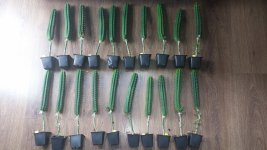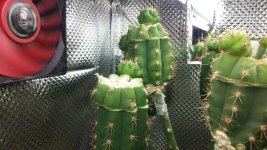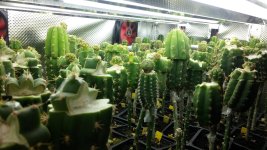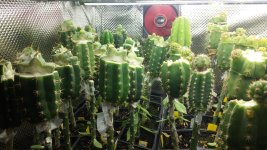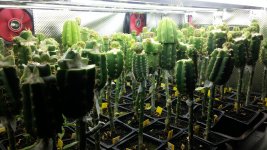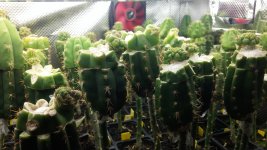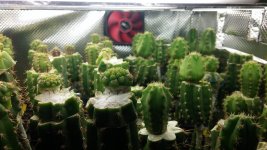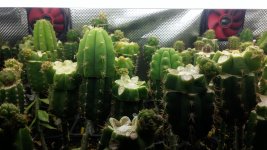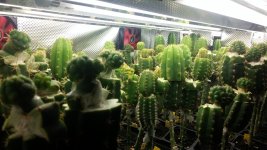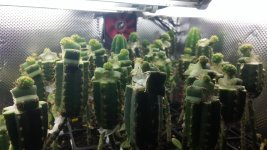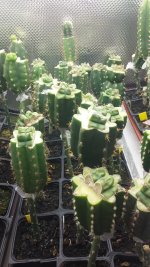pete666
Esteemed member
Hey guys, have been busy lately, so not posting anything, but back again with some info.
I have already degrafted and taste-tested 267 pieces. About 160 are still waiting.
Average weight of one piece is 147g raw. Average growth is 0,83g/day. This is an average over all species, I am pretty sure it may be over 1g without any problems with optimal conditions and proper genes.
The yield for 1m2 is 27,62kg of raw material for half year period. For specimen containing 0,1% of mescaline, this is providing not bad 27,5g of mescaline per m2.
56% of the specimens were without any sign of bitterness, 27% had very weak bitter taste. So all these specimens (83%) were discarded. 10 specimens were selected for their bitterness quality. The rest was not disposed, but stored in dark place to increase mescaline content before extraction.
The specimens were cut with about 1:2 ratio, leaving 1/3 as a rootstock. I don't see any reason not to use it as long as possible. Pereskiopsis lost almost all of its leaves, but it doesn't seem to lose it's growth vigor. Why not use it for years this way?
The body of selected specimens was cut into 1,5-2cm stars and these were slab-grafted onto the aforementioned rootstocks. The rootstocks were without any bevel, just flat. Rubber band rocks here. Stretched parafilm helped to keep the moisture for about two weeks. First week without light, second with half light. The scions shrivelled up quite a lot, but were back to normal withing about a week. Most of them pupped withing 3 weeks from grafting.
Slab grafting of whole stars is not as convenient. It is much better to cut these stars into two pieces, so twice as much clones are propagated.
One specimen can be propagated to about 15-20 clones this way
The take rate here is very good, more than 95%.
2% 6-BAP in lanoline was used to induce pupping. This works wonders, but as the scions seem to pup even without that, it seems to be unnecessary. 2% 6-BAP seems to be quite strong, I would suggest to go rather with 1%. I believe young areoles (my are max 6 months old) are puping very readily. Maybe older areoles might need some help of this miracle tool.
The description of taste testing and bitterness results will be published shortly in another thread. They were very surprising for me, not as good as I expected, but still providing some potential for the future.
I have already degrafted and taste-tested 267 pieces. About 160 are still waiting.
Average weight of one piece is 147g raw. Average growth is 0,83g/day. This is an average over all species, I am pretty sure it may be over 1g without any problems with optimal conditions and proper genes.
The yield for 1m2 is 27,62kg of raw material for half year period. For specimen containing 0,1% of mescaline, this is providing not bad 27,5g of mescaline per m2.
56% of the specimens were without any sign of bitterness, 27% had very weak bitter taste. So all these specimens (83%) were discarded. 10 specimens were selected for their bitterness quality. The rest was not disposed, but stored in dark place to increase mescaline content before extraction.
The specimens were cut with about 1:2 ratio, leaving 1/3 as a rootstock. I don't see any reason not to use it as long as possible. Pereskiopsis lost almost all of its leaves, but it doesn't seem to lose it's growth vigor. Why not use it for years this way?
The body of selected specimens was cut into 1,5-2cm stars and these were slab-grafted onto the aforementioned rootstocks. The rootstocks were without any bevel, just flat. Rubber band rocks here. Stretched parafilm helped to keep the moisture for about two weeks. First week without light, second with half light. The scions shrivelled up quite a lot, but were back to normal withing about a week. Most of them pupped withing 3 weeks from grafting.
Slab grafting of whole stars is not as convenient. It is much better to cut these stars into two pieces, so twice as much clones are propagated.
One specimen can be propagated to about 15-20 clones this way
The take rate here is very good, more than 95%.
2% 6-BAP in lanoline was used to induce pupping. This works wonders, but as the scions seem to pup even without that, it seems to be unnecessary. 2% 6-BAP seems to be quite strong, I would suggest to go rather with 1%. I believe young areoles (my are max 6 months old) are puping very readily. Maybe older areoles might need some help of this miracle tool.
The description of taste testing and bitterness results will be published shortly in another thread. They were very surprising for me, not as good as I expected, but still providing some potential for the future.

